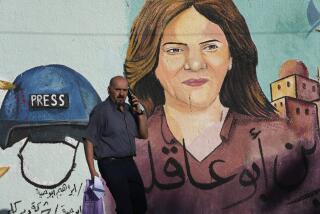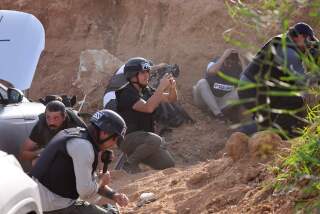U.S. Says Soldiers Killed 2 Journalists
BAGHDAD — The U.S. military took responsibility Monday for the shooting deaths this month of two Iraqis working for the Al Arabiya television channel but said soldiers were acting in self-defense and killed the journalists by accident.
Meanwhile, a spate of violence in the city of Mosul is leading military strategists to consider beefing up operations in northern Iraq, three months after they said the region’s relative quiet justified a 50% reduction in the number of troops there.
In violence elsewhere Monday, a U.S. soldier was killed by a roadside bomb near Fallouja, west of Baghdad.
Army officials -- who initially questioned whether U.S. forces were to blame in the March 18 deaths of the Al Arabiya reporter and cameraman near a checkpoint in Baghdad -- said Monday that they regretted the incident and would offer compensation to the families of the journalists, Ali Khatib, 34, and Ali Abdul Aziz, 35.
“The coalition forces are accepting responsibility for the shootings,” a senior U.S. official said. Although the military said the soldiers broke no rules of engagement and would face no punishment, the acknowledgment was an unusually blunt admission compared with previous cases involving accidental shootings of civilians. An official in the satellite TV channel’s Baghdad bureau declined to comment on the military’s decision late Monday.
A day after the killings, more than 30 Iraqi journalists protested at a news conference called by Secretary of State Colin L. Powell and then staged a walkout. “The security situation in Iraq has become tragic,” one of the journalists told Powell. “It is impossible to live with.”
After an investigation, the military concluded that the journalists’ vehicle was hit by four to six rounds of fire after U.S. soldiers began shooting at a white Volvo that had rammed the checkpoint.
The journalists, driving 50 to 150 yards behind the Volvo, were turning their vehicle around to leave when they were caught in the fire, the military said. The investigation found that eight soldiers fired as many as 10 shots each at the Volvo.
Several other journalists have been killed by U.S. forces in Iraq, including two Reuters cameramen and one working for a Spanish network. Last week, an Iraqi cameraman working for ABC was shot to death while covering clashes between U.S. forces and suspected insurgents west of Baghdad.
In Mosul, growing unrest and violence are prompting military officials to consider boosting the U.S. presence in northern Iraq, a senior military official said. Though no decisions have been made, military leaders have expressed concern to Brig. Gen. Carter F. Ham, who commands coalition forces in the region.
“We’re taking a hard look at it,” the senior official said, speaking on the condition of anonymity. “There have been a couple of incidents, probably a few more than normal, up in Mosul. We are taking a very close look at the number of operations we’re running up there to see if that is a place where we need to resource more efforts.”
In January, 9,500 troops with the Stryker brigade replaced about 19,000 soldiers with the 101st Airborne Division. It marked the sharpest regional reduction of U.S. forces in Iraq under the current troop rotation.
In recent days, attacks in the Mosul area have escalated. On Sunday, gunmen killed two foreign guards -- one British and one Canadian -- protecting engineers at a General Electric Co. power project.
In a separate incident, attackers attempted to assassinate Iraqi Public Works Minister Nasreen Mustafa Sadiq. She survived, but her driver and a bodyguard were slain.
On Saturday, missiles slammed into the local government headquarters in Mosul, killing two people and wounding 19. In mid-March, four U.S. missionaries were slain in the city.
More to Read
Sign up for Essential California
The most important California stories and recommendations in your inbox every morning.
You may occasionally receive promotional content from the Los Angeles Times.










